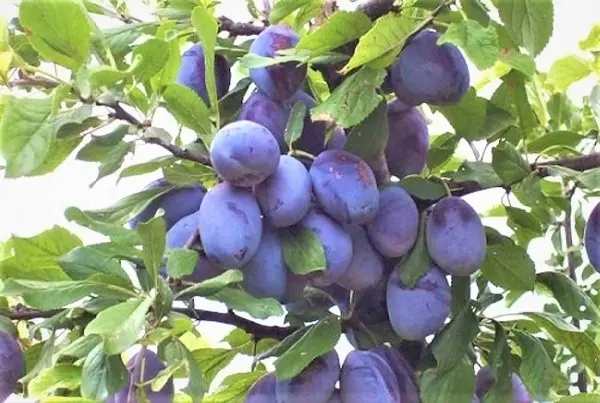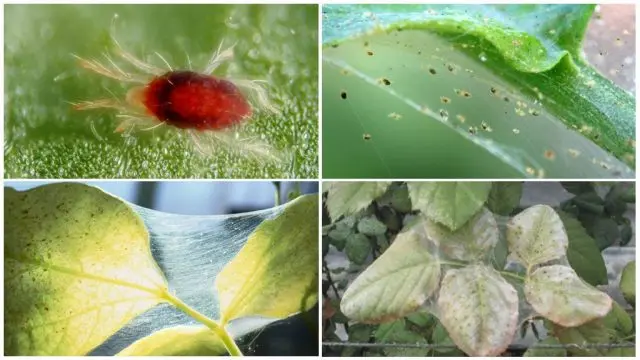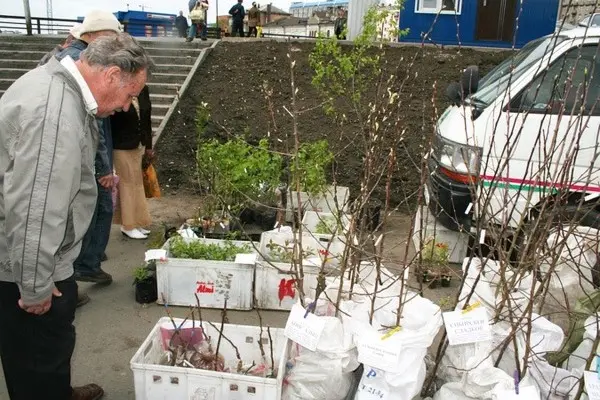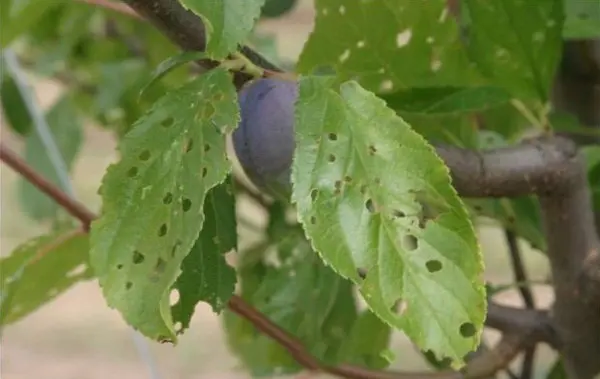Contents
Plum Hope – one of the most common in the northern latitudes. The climate of the Far East region suits her perfectly, and therefore it bears fruit abundantly. This is one of the few plum varieties for this area.
History of variety breeding
The variety was obtained by the Khabarovsk garden and berry breeding station from free pollination of the Ussuri plum, red cherry plum and Manchurian prunes. The author is a breeder L. G. Setkova. The variety has been included in the State Register since 2018.
Description of the plum variety Nadezhda
The main task of breeders was to obtain a crop in the conditions of a short northern summer. As a result, ultra-early species were bred, in particular, the Nadezhda plum. In the conditions of Primorsky Krai, it brings a fairly large crop.

- The plum variety Nadezhda Primorye is undersized. It reaches no more than 2,5 m in length. At the same time, it has a wide spreading oval-shaped crown. Short brown shoots surround the trunk.
- The leaf is small, oblong, dark green in color, with small frequent teeth. This plum is a long-liver, bearing fruit for 15 to 25 years.
- The fruits are small, oblong, dark blue in color, with a whitish coating. The average weight is 27 g, the largest is 35 g. The taste is sweet, but not cloying, with a slight sourness.
- The pulp of the fruit is dry, not very juicy, yellow. Aroma of pineapple fruit. The bone separates badly. The skin is thin, with a sour taste.
- An early variety – harvesting occurs at the beginning of August. Until full ripening, the fruits from the tree do not fall.
- Average yield – up to 25 kg per tree. The first fruits are obtained 2-3 years after planting the seedling.
Characteristics of a variety
Plum Nadezhda Primorye is characterized by medium yield and early fruit ripening. An undoubted plus for gardeners is the fruiting of a tree for 2-3 years after planting. It is a culture of universal purpose.
Drought resistance, frost resistance
The plum variety Nadezhda easily tolerates Far Eastern frosts, shoots are distinguished by high winter hardiness, and flowers are medium.
It also easily copes with drought, you can only water a few times during the summer season. The only thing that needs to be controlled is excessive soil moisture. Plum does not like this.
In warm regions, it may not take root, the roots may rot. In any conditions, it bears fruit annually.
Pollinators
Plum Hope does not require pollinators. This is a self-fertile variety. He himself acts as a pollinator, but bears fruit well only when cross-pollinated.
Plum must be planted surrounded by several other varieties. Good yields will be given by self-fertile and partially self-fertile varieties growing nearby. All types of Chinese, Far Eastern and Ussuri plums are well suited, such as:
- Kseniya;
- Khabarovsk early;
- Amur early;
- The dawn is early.
All these varieties are early ripening, so the timing of their flowering and pollination coincide.
Yield and fruiting

Plum Nadezhda Primorye bears fruit for 3 years after planting. This early variety ripens in the first half of August. Until ripening, the fruits from the tree do not crumble. Up to 25 kg of fruit can be harvested per season from one tree. The variety is considered medium.
Scope of berries
The fruits of the Nadezhda variety are most often used for making desserts, pastries, and juices. Plum is well suited for harvesting for the winter. You can make drying out of fruits. Delicious candied fruits will turn out.
Disease and pest resistance
The main pests of the Nadezhda variety include:
- spider mite;
- sawfly;
- moth;
- moth;
- aphid.
spider mite can damage all shoots of the plant. He destroys the plum completely – the tree turns into a cocoon entangled in cobwebs. First, the tick eats only the lower branches of the plant, then rises up and destroys the greens, inflorescences and fruit ovaries. The tree is treated with “Antiklesh” in the spring, during the growing season. When the first pest settlements are found, it is necessary to treat them with chemicals. At a later date, the funds will be ineffective.

black sawfly appears shortly before the beginning of the flowering period of plums. Lays eggs in tree flowers. One individual infects several dozen buds. During the period of ovary initiation, larvae appear that eat the fruit and the stone. Uncontrolled reproduction of this insect is fraught with the loss of the entire crop. It is necessary to carry out spraying with the help of special means. Fruits damaged by this pest are destroyed. In autumn they dig up the soil under the tree.
Advantages and disadvantages of the variety
The main advantages of this variety include its frost resistance. Plum does not die even at the lowest temperature.
You can also highlight the following positive properties:
- early ripening of fruits;
- high productivity for the northern regions;
- self-fertility;
- good taste;
- early fruiting.
The plum variety Nadezhda was bred in the northern region and became widespread there. One of its shortcomings is poor survival in the southern regions.
Other disadvantages of the variety:
- susceptibility to root rot;
- lack of immunity to pests;
- weak survival in a humid, warm climate.
The plum variety Nadezhda Primorye bears fruit well in the northern regions due to its frost resistance and is completely unsuitable for regions with hot weather and abundantly moistened soil.
Features of landing
For abundant fruiting and proper development of the seedling, it is necessary to create the proper conditions for planting.

Recommended dates
Variety Nadezhda prefers chernozem soils with a small admixture of clay. Does not tolerate the proximity of groundwater. Plums are planted in the spring, at the end of frosts, or in the fall, before they occur.
Choosing the right place
For plums, well-lit areas without drafts are preferred. It is good to plant a plum of the Nadezhda variety on a hill. It thrives well on forest floor. Usually a young plant is planted – up to a year.
What crops can and cannot be planted nearby
Plum Nadezhda of Primorye is a stunted plant that does not tolerate shading.
- It is impossible to plant nearby tall trees with a large crown that can shade the plum.
- It is good to plant nearby other varieties of self-fertile and non-self-fertile plums of early ripening.
- It is ideal to plant a cherry plum nearby.
Selection and preparation of planting material
The tree propagates by seed or grafting.
To get a bone, choose a healthy ripe fruit that has fallen off the tree on its own. The bone is separated after the fetus rests. The seed is planted in spring or autumn in warm soil. After planting, this place should be insulated with sawdust.
You can watch this video to see the process:
You can plant a plum seedling by choosing a suitable specimen in the nursery. Young trees up to a year old with a straight trunk and a developed root system are suitable for planting. The rhizome is wrapped in a dense cloth and the plant is left in a dark, cool place before planting.
Landing algorithm
- To plant the plum Hope, they dig a rather large hole.
- Manure is loaded into it – 1 bucket, potassium salt – 30 g and superphosphates – 1,5 cups.
- It is good to pour sawdust around the hole to prevent moisture from evaporating.
- A peg is driven into the center, a seedling is placed nearby, which is attached to a support.
- The rhizome is covered with loose soil and trampled down.
- Then water the young tree under the root.
Plum Aftercare
The plum variety Nadezhda is picky about growing conditions.
- It is good to make the first dressing of the seedling the next year after planting. Seedling fertilizer is produced by watering the root with potassium sulfate (60 g) and urea (60 g) dissolved in 10 liters of water. It is also necessary to add plums 3 times a year with nitrogenous fertilizers.
- After planting, the seedling is cut back to 50% of its original size. This stimulates the growth of young shoots.
How to properly prune young plum seedlings, you can learn from this video:
- An adult tree is pruned as needed up to 2 times a year: in spring, before the juice begins to move, and in autumn, after harvesting. Remove old dry shoots and branches, form a spherical crown.
- In the autumn, after harvesting, the plum is fertilized and watered until frost.
- The plum variety Nadezhda is not wrapped up from the cold: it is able to endure any frost. You can wrap the trunk for the winter with dense material to protect the bark from damage by rodents.
Diseases and pests, methods of control and prevention
Plum variety Nadezhda Primorye is practically not afraid of pests and is able to endure any disease.
The main pest of Nadezhda is the codling moth. It affects both the leaves and the fruits of the plant. Spraying is chosen as a struggle. It starts during the flowering period and is carried out every 2 weeks. Complete a month before fruit ripening.

The plum variety Nadezhda Primorye in rare cases can be affected by monoliosis and clasterosporiosis. For prevention purposes, before fruiting, the foliage is treated with a Bordeaux mixture (3%).
Conclusion
Plum Hope is a good choice for the northern regions. High survival rate and frost resistance are the best suited for the weather conditions inherent in these regions. Early fruiting also distinguishes this plum from other species.









